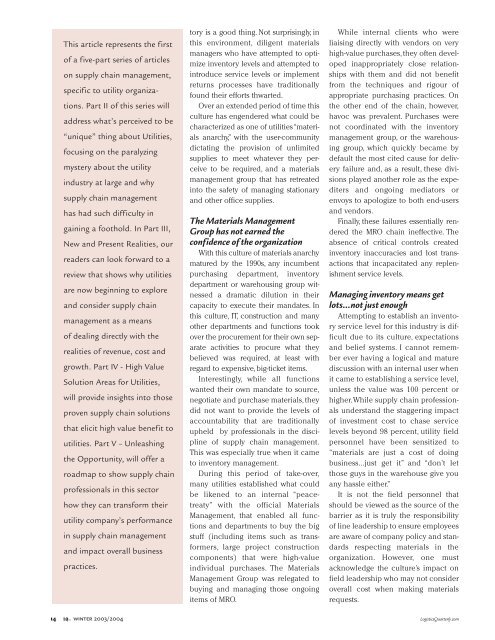Reverse Logistics - Logistics Quarterly
Reverse Logistics - Logistics Quarterly
Reverse Logistics - Logistics Quarterly
You also want an ePaper? Increase the reach of your titles
YUMPU automatically turns print PDFs into web optimized ePapers that Google loves.
This article represents the first<br />
of a five-part series of articles<br />
on supply chain management,<br />
specific to utility organiza-<br />
tions. Part II of this series will<br />
address what’s perceived to be<br />
“unique” thing about Utilities,<br />
focusing on the paralyzing<br />
mystery about the utility<br />
industry at large and why<br />
supply chain management<br />
has had such difficulty in<br />
gaining a foothold. In Part III,<br />
New and Present Realities, our<br />
readers can look forward to a<br />
review that shows why utilities<br />
are now beginning to explore<br />
and consider supply chain<br />
management as a means<br />
of dealing directly with the<br />
realities of revenue, cost and<br />
growth. Part IV - High Value<br />
Solution Areas for Utilities,<br />
will provide insights into those<br />
proven supply chain solutions<br />
that elicit high value benefit to<br />
utilities. Part V – Unleashing<br />
the Opportunity, will offer a<br />
roadmap to show supply chain<br />
professionals in this sector<br />
how they can transform their<br />
utility company’s performance<br />
in supply chain management<br />
and impact overall business<br />
practices.<br />
14 LQ winter 2003/2004<br />
tory is a good thing. Not surprisingly, in<br />
this environment, diligent materials<br />
managers who have attempted to optimize<br />
inventory levels and attempted to<br />
introduce service levels or implement<br />
returns processes have traditionally<br />
found their efforts thwarted.<br />
Over an extended period of time this<br />
culture has engendered what could be<br />
characterized as one of utilities “materials<br />
anarchy,” with the user-community<br />
dictating the provision of unlimited<br />
supplies to meet whatever they perceive<br />
to be required, and a materials<br />
management group that has retreated<br />
into the safety of managing stationary<br />
and other office supplies.<br />
The Materials Management<br />
Group has not earned the<br />
confidence of the organization<br />
With this culture of materials anarchy<br />
matured by the 1990s, any incumbent<br />
purchasing department, inventory<br />
department or warehousing group witnessed<br />
a dramatic dilution in their<br />
capacity to execute their mandates. In<br />
this culture, IT, construction and many<br />
other departments and functions took<br />
over the procurement for their own separate<br />
activities to procure what they<br />
believed was required, at least with<br />
regard to expensive, big-ticket items.<br />
Interestingly, while all functions<br />
wanted their own mandate to source,<br />
negotiate and purchase materials,they<br />
did not want to provide the levels of<br />
accountability that are traditionally<br />
upheld by professionals in the discipline<br />
of supply chain management.<br />
This was especially true when it came<br />
to inventory management.<br />
During this period of take-over,<br />
many utilities established what could<br />
be likened to an internal “peacetreaty”<br />
with the official Materials<br />
Management, that enabled all functions<br />
and departments to buy the big<br />
stuff (including items such as transformers,<br />
large project construction<br />
components) that were high-value<br />
individual purchases. The Materials<br />
Management Group was relegated to<br />
buying and managing those ongoing<br />
items of MRO.<br />
While internal clients who were<br />
liaising directly with vendors on very<br />
high-value purchases,they often developed<br />
inappropriately close relationships<br />
with them and did not benefit<br />
from the techniques and rigour of<br />
appropriate purchasing practices. On<br />
the other end of the chain, however,<br />
havoc was prevalent. Purchases were<br />
not coordinated with the inventory<br />
management group, or the warehousing<br />
group, which quickly became by<br />
default the most cited cause for delivery<br />
failure and, as a result, these divisions<br />
played another role as the expediters<br />
and ongoing mediators or<br />
envoys to apologize to both end-users<br />
and vendors.<br />
Finally, these failures essentially rendered<br />
the MRO chain ineffective. The<br />
absence of critical controls created<br />
inventory inaccuracies and lost transactions<br />
that incapacitated any replenishment<br />
service levels.<br />
Managing inventory means get<br />
lots…not just enough<br />
Attempting to establish an inventory<br />
service level for this industry is difficult<br />
due to its culture, expectations<br />
and belief systems. I cannot remember<br />
ever having a logical and mature<br />
discussion with an internal user when<br />
it came to establishing a service level,<br />
unless the value was 100 percent or<br />
higher.While supply chain professionals<br />
understand the staggering impact<br />
of investment cost to chase service<br />
levels beyond 98 percent, utility field<br />
personnel have been sensitized to<br />
“materials are just a cost of doing<br />
business...just get it” and “don’t let<br />
those guys in the warehouse give you<br />
any hassle either.”<br />
It is not the field personnel that<br />
should be viewed as the source of the<br />
barrier as it is truly the responsibility<br />
of line leadership to ensure employees<br />
are aware of company policy and standards<br />
respecting materials in the<br />
organization. However, one must<br />
acknowledge the culture’s impact on<br />
field leadership who may not consider<br />
overall cost when making materials<br />
requests.<br />
<strong>Logistics</strong><strong>Quarterly</strong>.com







